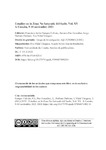Mostrar o rexistro simple do ítem
Continuous and discrete adjoint state formulations of conservative and reactive solute transport in porous media
| dc.contributor.author | Core Samper, A. | |
| dc.contributor.author | Samper, Javier | |
| dc.contributor.author | Mon, Alba | |
| dc.contributor.author | Yang, Changbing | |
| dc.contributor.author | Lentijo, F. | |
| dc.date.accessioned | 2024-09-10T16:49:38Z | |
| dc.date.available | 2024-09-10T16:49:38Z | |
| dc.date.issued | 2021 | |
| dc.identifier.citation | Core Samper, A., Samper, J., Mon, A., Yang, C., Lentijo, F. (2021). Continuous and discrete adjoint state formulations of conservative and reactive solute transport in porous media. En Samper F.J., Paz A., Dafonte J. y Vidal E., eds., Estudios en la Zona No Saturada del Suelo, Vol. XV. A Coruña, 9-10 noviembre 2021, pp. 241-250. https://doi.org/10.17979/spudc.9788497498210 | es_ES |
| dc.identifier.isbn | 978-84-9749-821-0 | |
| dc.identifier.uri | http://hdl.handle.net/2183/38955 | |
| dc.description.abstract | [Resumen:] El método del estado adjunto (AS) es comúnmente utilizado para calcular las derivadas locales de la función objetivo del problema inverso de la estimación automática de los parámetros de modelos numéricos de flujo y transporte de solutos y para calcular las sensibilidades de los resultados de los modelos a variaciones de sus parámetros. El método AS se puede aplicar: (a) Al problema original (método continuo) o (b) A la versión discretizada del problema original (método discreto). El método AS continuo consiste en obtener las ecuaciones del estado adjunto a partir de las ecuaciones en derivadas parciales del problema original y, posteriormente, resolver numéricamente dichas ecuaciones. El método AS discreto consiste en obtener las ecuaciones del estado adjunto directamente a partir de las ecuaciones discretizadas del problema original. Este trabajo presenta la formulación del estado adjunto continuo y discreto para el transporte de solutos conservativos y reactivos en medios porosos. Se incluye la descripción de los dos métodos, el análisis de sus propiedades y la comparación de ambas versiones así como su aplicación a sistemas multicomponente de solutos conservativos y sistemas reactivos con reacciones de disolución/precipitación de minerales y de intercambio catiónico. | es_ES |
| dc.description.abstract | [Abstract:] The adjoint state (AS) method is commonly used for calculating local derivatives of objective functions in the solution of the inverse problem of parameter estimation and computing model sensitivities for water flow and solute transport. The AS method can be applied to: (a) The continuous version of the original problem (continuous AS method) and (b) The discretized form of the original problem (discrete AS method). The continuous AS method consists on deriving the AS equations from the partial differential equations (PDEs) of the original problem and then solving numerically the resulting PDEs of the AS. The discrete adjoint state method consists on obtaining the discretized AS equations directly from the discretized equations of the original problem. Here we present the formulation of both the continuous and discrete AS for conservative solute transport in porous media. The methods are described and the properties of both continuous and discrete AS formulations are analysed and compared. We also present the AS equations for multicomponent reactive systems with mineral dissolution/precipitation and cation exchange reactions. | es_ES |
| dc.description.sponsorship | Acknowledgements. The research leading to these results was funded by ENRESA through a Research Contract within the Work Package DONUT of EURAD (European Joint Programme on Radioactive Waste Management of the European Union, Grant Agreement, 847593). The work was partly funded also by the Spanish Ministry of Economy and Competitiveness (Project PID2019-109544RB-I00) and the Galician Regional Government (Grant number ED431C2021/54 from “Consolidación e estruturación de unidades de investigación competitivas”). We acknowledge Carlos López for his support and comments. | es_ES |
| dc.description.sponsorship | Xunta de Galicia; ED431C2021/54 | es_ES |
| dc.language.iso | eng | es_ES |
| dc.publisher | Universidade da Coruña, Servizo de Publicacións | es_ES |
| dc.relation | info:eu-repo/grantAgreement/EC/H2020/847593 | es_ES |
| dc.relation | info:eu-repo/grantAgreement/MINECO/Plan Estatal de Investigación Científica y Técnica y de Innovación 2017-2020/PID2019-109544RB-I00/ES/MODELOS DE TRANSPORTE DE MASA E INTERACCIONES GEOQUIMICAS EN INTERFACES HETEROGENEAS, IRREGULARES Y MULTIPLES EN MEDIOS POROSOS Y FRACTURADOS CON GRADIENTES HIDRAULICOS, TERMI | es_ES |
| dc.relation.uri | https://doi.org/10.17979/spudc.9788497498210 | es_ES |
| dc.rights | Atribución-NoComercial-CompartirIgual 3.0 España | es_ES |
| dc.rights.uri | http://creativecommons.org/licenses/by-nc-sa/3.0/es/ | * |
| dc.subject | Método del estado adjunto (AS) | es_ES |
| dc.subject | Problema inverso | es_ES |
| dc.subject | Modelos numéricos | es_ES |
| dc.subject | Flujo de solutos | es_ES |
| dc.subject | Transporte de solutos | es_ES |
| dc.subject | Adjoint state method (AS) | es_ES |
| dc.subject | Inverse problem | es_ES |
| dc.subject | Numerical models | es_ES |
| dc.subject | Solute flux | es_ES |
| dc.subject | Solute transport | es_ES |
| dc.title | Continuous and discrete adjoint state formulations of conservative and reactive solute transport in porous media | es_ES |
| dc.type | info:eu-repo/semantics/conferenceObject | es_ES |
| dc.rights.access | info:eu-repo/semantics/openAccess | es_ES |
| UDC.startPage | 241 | es_ES |
| UDC.endPage | 250 | es_ES |
| dc.identifier.doi | 10.17979/spudc.9788497498210 | |
| UDC.conferenceTitle | Estudios en la Zona No Saturada del Suelo (15. 2021. A Coruña) | es_ES |






